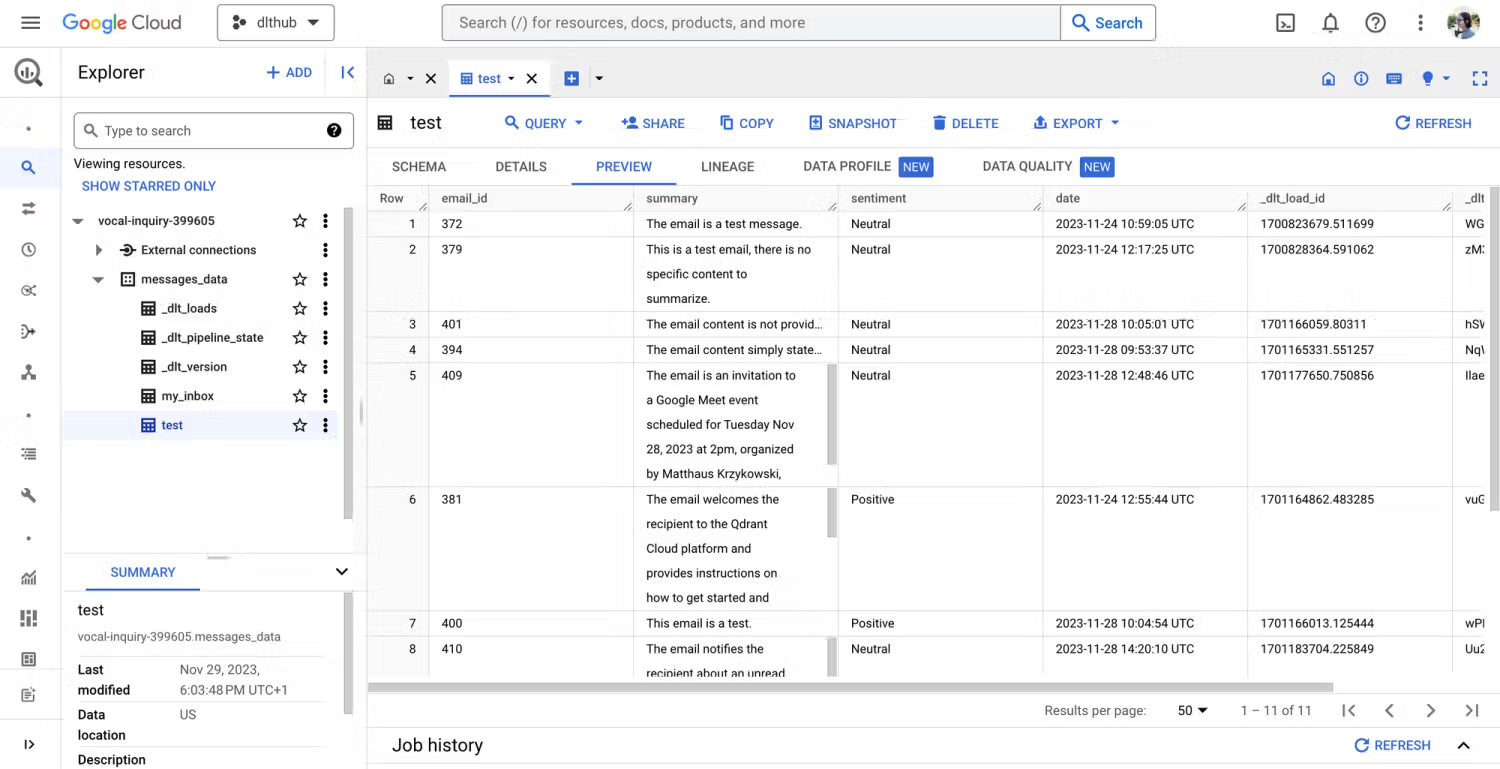From Inbox to Insights: AI-enhanced email analysis with dlt and Kestra
 Anuun Chinbat,
Anuun Chinbat,
Junior Software Engineer
THE PROBLEM
There are two types of people: those who hoard thousands of unread emails in their inbox and those who open them immediately to avoid the ominous red notification. But one thing unites us all: everyone hates emails. The reasons are clear:
- They're often unnecessarily wordy, making them time-consuming.
- SPAM (obviously).
- They become black holes of lost communication because CC/BCC-ing people doesn't always work.
- Sometimes, there are just too many.
So, this post will explore a possible remedy to the whole email issue involving AI.
THE SOLUTION
Don't worry; it's nothing overly complex, but it does involve some cool tools that everyone could benefit from.
💡 In a nutshell, I created two flows (a main flow and a subflow) in Kestra :
- The main flow extracts email data from Gmail and loads it into BigQuery using
dlt, checks for new emails, and, if found, triggers the subflow for further processing. - The subflow utilizes OpenAI to summarize and analyze the sentiment of an email, loads the results into BigQuery, and then notifies about the details via Slack.
Just so you're aware:
Kestrais an open-source automation tool that makes both scheduled and event-driven workflows easy.dltis an open-source library that you can add to your Python scripts to load data from various and often messy data sources into well-structured, live datasets.
Wanna jump to the GitHub repo?
HOW IT WORKS
To lay it all out clearly: Everything's automated in Kestra, with hassle-free data loading thanks to dlt, and the analytical thinking handled by OpenAI. Here's a diagram to help you understand the general outline of the entire process.

Now, let's delve into specific parts of the implementation.
The environment:
💡 The two flows in Kestra are set up in a very straightforward and intuitive manner. Simply follow the Prerequisites and Setup guidelines in the repo. It should take no more than 15 minutes.
Once you’ve opened http://localhost:8080/ in your browser, this is what you’ll see on your screen:

Now, all you need to do is create your flows and execute them.
The great thing about Kestra is its ease of use - it's UI-based, declarative, and language-agnostic. Unless you're using a task like a Python script, you don't even need to know how to code.
Kestra for your projects, consult their documentation and the plugin pages for further insights. The data loading part
💡 This is entirely managed by dlt in just five lines of code.I set up a pipeline using the Inbox source – a regularly tested and verified source from dlt – with BigQuery as the destination.
In my scenario, the email data doesn't have nested structures, so there's no need for flattening. However, if you encounter nested structures in a different use case, dlt can automatically normalize them during loading.
Here's how the pipeline is defined and subsequently run in the first task of the main flow in Kestra:
# Run dlt pipeline to load email data from gmail to BigQuery
pipeline = dlt.pipeline(
pipeline_name="standard_inbox",
destination='bigquery',
dataset_name="messages_data",
dev_mode=False,
)
# Set table name
table_name = "my_inbox"
# Get messages resource from the source
messages = inbox_source(start_date = pendulum.datetime(2023, 11, 15)).messages
# Configure the messages resource to get bodies of the emails
messages = messages(include_body=True).with_name(table_name)
# Load data to the "my_inbox" table
load_info = pipeline.run(messages)In this setup ☝️, dlt loads all email data into the table “my_inbox”, with the email body specifically stored in the “body” column. After executing your flow in Kestra, the table in BigQuery should appear as shown below:

dlt here. The AI part
💡 In this day and age, how can we not incorporate AI into everything? 😆
But seriously, if you're familiar with OpenAI, it's a matter of an API call to the chat completion endpoint. What simplifies it even further is Kestra’s OpenAI plugin.
In my subflow, I used it to obtain both the summary and sentiment analysis of each email body. Here's a glimpse of how it's implemented:
- id: get_summary
type: io.kestra.plugin.openai.ChatCompletion
apiKey: "{{ secret('OPENAI_API') }}"
model: gpt-3.5-turbo
prompt: "Summarize the email content in one sentence with less than 30 words: {{inputs.data[0]['body']}}"
messages: [{"role": "system", "content": "You are a tool that summarizes emails."}]Kestra also includes Slack, as well as BigQuery plugins, which I used in my flows. Additionally, there is a wide variety of other plugins available. The automation part
💡 Kestra triggers are the ideal solution!I’ve used a schedule trigger that allows you to execute your flow on a regular cadence e.g. using a CRON expression:
triggers:
- id: schedule
type: io.kestra.core.models.triggers.types.Schedule
cron: "0 9-18 * * 1-5"This configuration ensures that your flows are executed hourly on workdays from 9 AM to 6 PM.
THE OUTCOME
A Slack assistant that delivers crisp inbox insights right at your fingertips:

And a well-organized table in BigQuery, ready for you to dive into a more complex analysis:

In essence, using Kestra and dlt offers a trio of advantages for refining email analysis and data workflows:
- Efficient automation:
Kestraeffortlessly orchestrates intricate workflows, integrating smoothly with tools likedlt, OpenAI, and BigQuery. This process reduces manual intervention while eliminating errors, and freeing up more time for you. - User-friendly and versatile: Both
Kestraanddltare crafted for ease of use, accommodating a range of skill levels. Their adaptability extends to various use cases. - Seamless scaling:
Kestra, powered by Kafka and Elasticsearch, adeptly manages large-scale data and complex workflows. Coupled withdlt's solid data integration capabilities, it ensures a stable and reliable solution for diverse requirements.
HOW IT COULD WORK ELSEWHERE
Basically, you can apply the architecture discussed in this post whenever you need to automate a business process!
For detailed examples of how Kestra can be utilized in various business environments, you can explore Kestra's use cases.
Embrace automation, where the only limit is your imagination! 😛